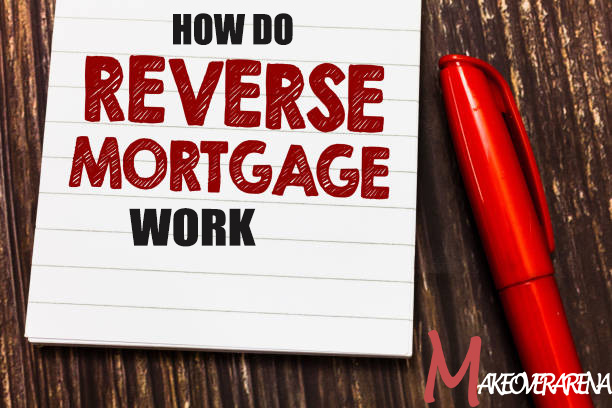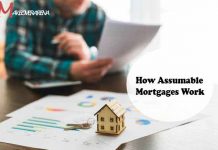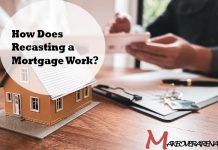How Do Reverse Mortgages Work? As individuals approach retirement age, they often consider various financial options to supplement their income. One such option that has gained popularity in recent years is a reverse mortgage. A reverse mortgage allows homeowners to tap into the equity built in their homes while retaining ownership.

In this article, we will explore the workings of reverse mortgages, including eligibility criteria, disbursement methods, repayment options, and potential benefits and considerations.
Reverse Mortgages
A reverse mortgage is a loan product designed specifically for homeowners aged 62 and older. Unlike a traditional mortgage, where borrowers make monthly payments to the lender, a reverse mortgage enables homeowners to receive payments from the lender. The loan is repaid when the homeowner no longer occupies the property as their primary residence.
When the borrower dies, moves out permanently, or sells the home, the entire loan balance, up to a certain limit, becomes due and payable. According to federal regulations, lenders must structure the transaction so that the loan amount does not exceed the home’s value. Even if it does, due to a decrease in the home’s market value or if the borrower lives longer than expected, the borrower or borrower’s estate will not be held liable for the difference due to the program’s mortgage insurance.
How Reverse Mortgage Works
People who are eligible for reverse mortgages usually own their homes outright. However, even if they have paid off their primary mortgage, they may not be able to borrow the full value of their home.
The amount that can be borrowed, which is called the principal limit, depends on factors such as the age of the youngest borrower or eligible non-borrowing spouse, current interest rates, the HECM mortgage limit (which was $1,089,300 in 2023), and the value of the home.
Older homeowners, those with more valuable properties, and those with lower interest rates are likely to have a higher principal limit. If the borrower has a variable-rate HECM, the amount may increase. With a variable rate, there are different options available including:
- Monthly payments must be equal if at least one borrower resides in the property as their primary residence.
- Equal monthly payments for a set number of months agreed upon in advance
- A credit line that can be used until it runs out.
- A combination of a line of credit and fixed monthly payments for the duration of your residence.
- A combination of a credit line and fixed monthly payments for a set period of time.
Types Of Reverse Mortgages
There are three major types of reverse mortgages for different financial needs. These three types are:
HECM (Home Equity Conversions Mortgages)
These federally insured reverse mortgages are the most common type of reverse mortgage, with higher upfront costs but funds that can be used for any purpose. You can also choose how the money is withdrawn, such as through fixed monthly payments or a line of credit (or both options simultaneously). Although widely available, HECMs are only available from FHA-approved lenders, and all borrowers must receive HUD-approved counseling prior to closing.
Proprietary Reverse Mortgage
This is a private loan that is not guaranteed by the government. This type of reverse mortgage typically provides a larger loan advance, especially if you own a higher-valued home.
Single-Purpose Reverse Mortgage
This mortgage is less common than the other two and is typically offered by nonprofit organizations as well as state and local government agencies.
A single-purpose mortgage is the least expensive of the three options; however, borrowers can only use the loan (typically for a much smaller amount) to cover one specific purpose, such as a handicap accessible remodel, explains Jackie Boies, senior director of housing and bankruptcy services for Money Management International, a nonprofit debt counselor based in Sugar Land, Texas.
Eligibility Criteria
To be eligible for a reverse mortgage, homeowners must meet certain criteria. Firstly, they need to be at least 62 years old. Secondly, the home must be their primary residence, meaning they live in it for the majority of the year. Additionally, homeowners must have sufficient equity in their homes. The exact amount of equity required varies depending on factors such as the homeowner’s age, the appraised value of the home, and current interest rates.
Disbursement Methods
Once approved for a reverse mortgage, homeowners have several options for receiving the loan proceeds. They can choose to receive a lump sum payment, which provides a large amount upfront. Alternatively, they may opt for monthly payments over a predetermined period or for the duration of their occupancy. Another choice is a line of credit, where homeowners can access funds as needed. Lastly, a combination of these disbursement methods is also available.
Repayment Options
Contrary to traditional mortgages, reverse mortgages do not require immediate repayment. Instead, repayment is typically due when the homeowner passes away, sells the home, or no longer uses it as their primary residence. At that point, the loan, along with any accrued interest and fees, must be repaid. The repayment amount is usually capped at the value of the home, ensuring that homeowners or their heirs will not owe more than the home is worth. If the proceeds from the sale of the home exceed the loan amount, the excess funds can be kept by the homeowner or their heirs.
Benefits and Considerations
Reverse mortgages offer several potential benefits for eligible homeowners. They provide a means to access the equity built in their homes, allowing for increased financial flexibility during retirement. The funds can be used to supplement retirement income, cover healthcare expenses, home improvements, or other financial needs. Furthermore, reverse mortgages do not require monthly mortgage payments, easing financial burdens for retirees.
However, it is crucial to consider some important factors before opting for a reverse mortgage. These include potential fees and closing costs, such as origination fees, mortgage insurance premiums, and appraisal fees. Additionally, borrowers must maintain their homes and continue to pay property taxes, homeowner’s insurance, and other property-related expenses.
Scams Related to Reverse Mortgage
Watch out for the following scams related to reverse mortgages:
Contractor scams
Be wary of contractors who approach you about obtaining a reverse mortgage loan to pay for home repairs. It could be a scam. Don’t allow yourself to be pushed into taking out a reverse mortgage loan.
Scams targeting veterans
The Veterans Administration (VA) does not provide reverse mortgage loans. To entice older Americans desperate to stay in their homes, some mortgage advertisements falsely promise veterans special deals, imply VA approval, or offer a “no-payment” reverse mortgage loan.
How Much Does Reverse Mortgage Cost
The cost of a reverse mortgage can vary depending on several factors. Here are some common costs associated with a reverse mortgage:
Origination Fee
This fee covers the lender’s administrative costs for processing the loan. It is typically a percentage of the loan amount.
Mortgage Insurance Premium (MIP)
Reverse mortgages insured by the Federal Housing Administration (FHA) require borrowers to pay an upfront MIP, which is a percentage of the loan amount, as well as an ongoing MIP that is charged annually.
Appraisal Fee
Before approving a reverse mortgage, lenders usually require an appraisal to determine the value of the property. The cost of the appraisal is typically paid by the borrower.
Closing Costs
Similar to traditional mortgages, reverse mortgages can have various closing costs, such as title search fees, recording fees, and attorney fees.
Servicing Fees
Some lenders charge monthly servicing fees to cover the costs of managing the loan, including sending statements and offering customer support.
Frequently Asked Questions
How Much Money Can You Get From A Reverse Mortgage?
The money you can receive from a reverse mortgage is determined by various factors, including the current value of your home, your age, interest rates, the specific type of reverse mortgage, associated expenses, and your financial evaluation. If there are any additional mortgages or liens on your home, the amount you receive may be affected as well.
How Do I Find a Reverse Mortgage Lender?
It can be challenging to find the appropriate lender for a reverse mortgage. When conducting your search, focus on two important aspects: cost and customer service. Take into account the interest rates and associated fees of the loan and ensure that the lender is cooperative and accommodating to work with.
Is A Reverse Mortgage a Good Idea?
Reverse mortgages can be advantageous in certain circumstances, but it is critical to understand the commitment and associated dangers. Before deciding on a reverse mortgage, carefully weigh the benefits and drawbacks and compare them to other financial choices you may be considering, such as home equity loans and home equity lines of credit (HELOCs). Furthermore, talking with a HECM counselor or financial expert is recommended to assess if a reverse mortgage corresponds with your goals.
CHECK THESE OUT:



